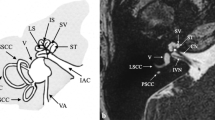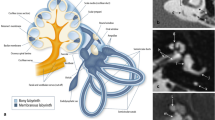Abstract
Objective
To describe the characteristics of the clinical presentation, diagnosis, surgical methods, and outcomes of patients with otogenic cerebrospinal fluid (CSF) leakage secondary to congenital inner ear dysplasia.
Methods
A retrospective review was performed of 18 patients with otogenic CSF leakage secondary to inner ear dysplasia who underwent surgery in our group from 2007 to 2017 and had a follow-up of at least 4 months. The average length of follow-up was three years. The characteristics of the clinical presentations of all patients, such as self-reported symptoms, radiographic findings, surgical approaches and methods of repair, position of the leakage during surgery, and postoperative course, including the success rate of surgery, are presented.
Results
The patients presented mostly with typical symptoms of meningitis, severe hearing impairment, and CSF otorrhea or rhinorrhea. All 18 patients had at least one previous episode of meningitis accompanied by a severe hearing impairment. The preoperative audiograms of 17 patients showed profound sensorineural hearing loss, and one patient had conductive hearing loss. Twelve patients presented with an initial onset of otorrhea, and two had accompanying rhinorrhea. Six patients complained of rhinorrhea, two of whom were misdiagnosed with CSF rhinorrhea and underwent transnasal endoscopy at another hospital. High-resolution computed tomography (HRCT) images can reveal developments in the inner ear, such as expansion of a vestibular cyst, unclear structure of the semicircular canal or cochlea, or signs of effusion in the middle ear or mastoid, which strongly suggest the possibility of CSF otorrhea. The children in the study suffered more severe dysplasia than adults. All 18 patients had CSF leakage identified during surgery. The most common defect sites were in the stapes footplates (55.6%), and 38.9% of patients had a leak around the oval window. One patient had a return of CSF otorrhea during the postoperative period, which did not re-occur following a second repair.
Conclusions
CSF otorrhea due to congenital inner ear dysplasia is more severe in children than in adults. The most common symptoms were meningitis, hearing impairment, and CSF otorrhea or rhinorrhea. HRCT has high diagnostic accuracy for this disease. The most common fistula site was around the oval window, including the stapes footplates and the annular ligament.
概 要
目 的
介绍先天性内耳发育不良继发耳源性脑脊液渗漏的临床表现、 诊断、 手术方法及预后。
创新点
总结了先天性内耳发育不良所致的脑脊液耳漏儿童与成人的畸形特点, 为先天性内耳畸形导致的脑脊液耳漏提供诊疗参考。
方 法
回顾性分析 2007~2017 年我组 18 例内耳发育不良继发耳源性脑脊液渗漏患者, 随访至少 4 个月, 平均随访时间为 3 年。 介绍所有患者的临床表现特点, 包括自述症状、 影像学表现、 手术方法及修复方法、 术中渗漏位置、 术后病程、 手术成功率等。
结 论
在先天性内耳发育不良所致的脑脊液耳漏中, 儿童的内耳畸形情况较成人更为严重。 最常见的症状是脑膜炎、 听力障碍和脑脊液耳漏或鼻漏。 高分辨率 CT (HRCT) 对本病具有较高的诊断准确率。 最常见的瘘口位于椭圆窗周围, 包括镫骨足板和环形韧带。
Similar content being viewed by others
References
Brown NE, Grundfast KM, Jabre A, et al., 2004. Diagnosis and management of spontaneous cerebrospinal fluid-middle ear effusion and otorrhea. Laryngoscope, 114(5):800–805. https://doi.org/10.1097/00005537-200405000-00002
Hernandez RN, Changa AR, Bassani L, et al., 2015. Cerebrospinal fluid otorrhea and pseudomonal meningitis in a child with Mondini dysplasia: case report. Childs Nerv Syst, 31(9):1613–1616. https://doi.org/10.1007/s00381-015-2836-x
Hoppe F, Hagen R, Hofmann E, 1997. Fistula of stapes footplate caused by pulsatile cerebrospinal fluid in inner ear malformation. ORL J Otorhinolaryngol Relat Spec, 59(2): 115–118. https://doi.org/10.1159/000276920
Jackler RK, Luxford WM, House WF, 1987. Congenital malformations of the inner ear: a classification based on embryogenesis. Laryngoscope, 97(S40):2–14. https://doi.org/10.1002/lary.5540971301
Janocha-Litwin J, Simon K, 2013. Recurrent meningitis—a review of current literature. Przegl Epidemiol, 67(1):41–45.
Kou YF, Zhu VF, Kutz JW Jr, et al., 2016. Transcanal endoscopic management of cerebrospinal fluid otorrhea secondary to congenital inner ear malformations. Otol Neurotol, 37(1): 62–65. https://doi.org/10.1097/MAO.0000000000000898
Lim R, Brichta AM, 2016. Anatomical and physiological development of the human inner ear. Hear Res, 338:9–21. https://doi.org/10.1016/j.heares.2016.02.004
Lin CY, Lin HC, Peng CC, et al., 2012. Mondini dysplasia presenting as otorrhea without meningitis. Pediatr Neonatol, 53(6):371–373. https://doi.org/10.1016/j.pedneo.2012.08.007
Lue AJ, Manolidis S, 2004. Intrathecal fluorescein to localize cerebrospinal fluid leakage in bilateral Mondini dysplasia. Otol Neurotol, 25(1):50–52.
Ohlms LA, Edwards MS, Mason EO, et al., 1990. Recurrent meningitis and Mondini dysplasia. Arch Otolaryngol Head Neck Surg, 116(5):608–612. https://doi.org/10.1001/archotol.1990.01870050108018
Rao AK, Merenda DM, Wetmore SJ, 2005. Diagnosis and management of spontaneous cerebrospinal fluid otorrhea. Otol Neurotol, 26(6):1171–1175. https://doi.org/10.1097/01.mao.0000179526.17285.cc
Savva A, Taylor MJ, Beatty CW, 2003. Management of cerebrospinal fluid leaks involving the temporal bone: report on 92 patients. Laryngoscope, 113(1):50–56. https://doi.org/10.1097/00005537-200301000-00010
Sennaroglu L, Saatci I, 2002. A new classification for cochleovestibular malformations. Laryngoscope, 112(12):2230–2241. https://doi.org/10.1097/00005537-200212000-00019
Tebruegge M, Curtis N, 2008. Epidemiology, etiology, pathogenesis, and diagnosis of recurrent bacterial meningitis. Clin Microbiol Rev, 21(3):519–537. https://doi.org/10.1128/CMR.00009-08
Teo DTW, Tan TY, Eng SP, et al., 2004. Spontaneous cerebrospinal fluid otorrhoea via oval window: an obscure cause of recurrent meningitis. J Laryngol Otol, 118(9):717–720. https://doi.org/10.1258/0022215042244804
Tyagi I, Syal R, Goyal A, 2005. Cerebrospinal fluid otorhinorrhoea due to inner-ear malformations: clinical presentation and new perspectives in management. J Laryngol Otol, 119(9):714–718. https://doi.org/10.1258/0022215054797934
Wilson MN, Simon LM, Arriaga MA, et al., 2014. The management of spontaneous otogenic CSF leaks: a presentation of cases and review of literature. J Neurol Surg B Skull Base, 75(2):117–124. https://doi.org/10.1055/s-0033-1359304
Yi HJ, Guo H, Ch W, et al., 2013. Use of the translabyrinthine approach to repair congenital spontaneous cerebrospinal fluid leakage in five Chinese patients with Mondini dysplasia. Int J Pediatr Otorhinolaryngol, 77(12):1965–1968. https://doi.org/10.1016/j.ijporl.2013.09.012
Author information
Authors and Affiliations
Corresponding authors
Additional information
Project supported by the National Natural Science Foundation of China (Nos. 81570914 and 81700925)
Rights and permissions
About this article
Cite this article
Wang, B., Dai, Wj., Cheng, Xt. et al. Cerebrospinal fluid otorrhea secondary to congenital inner ear dysplasia: diagnosis and management of 18 cases. J. Zhejiang Univ. Sci. B 20, 156–163 (2019). https://doi.org/10.1631/jzus.B1800224
Received:
Accepted:
Published:
Issue Date:
DOI: https://doi.org/10.1631/jzus.B1800224
Key words
- Cerebrospinal fluid
- Abnormality
- High-resolution computed tomography (HRCT)
- Congenital inner ear dysplasia
- Otorrhea
- Meningitis




